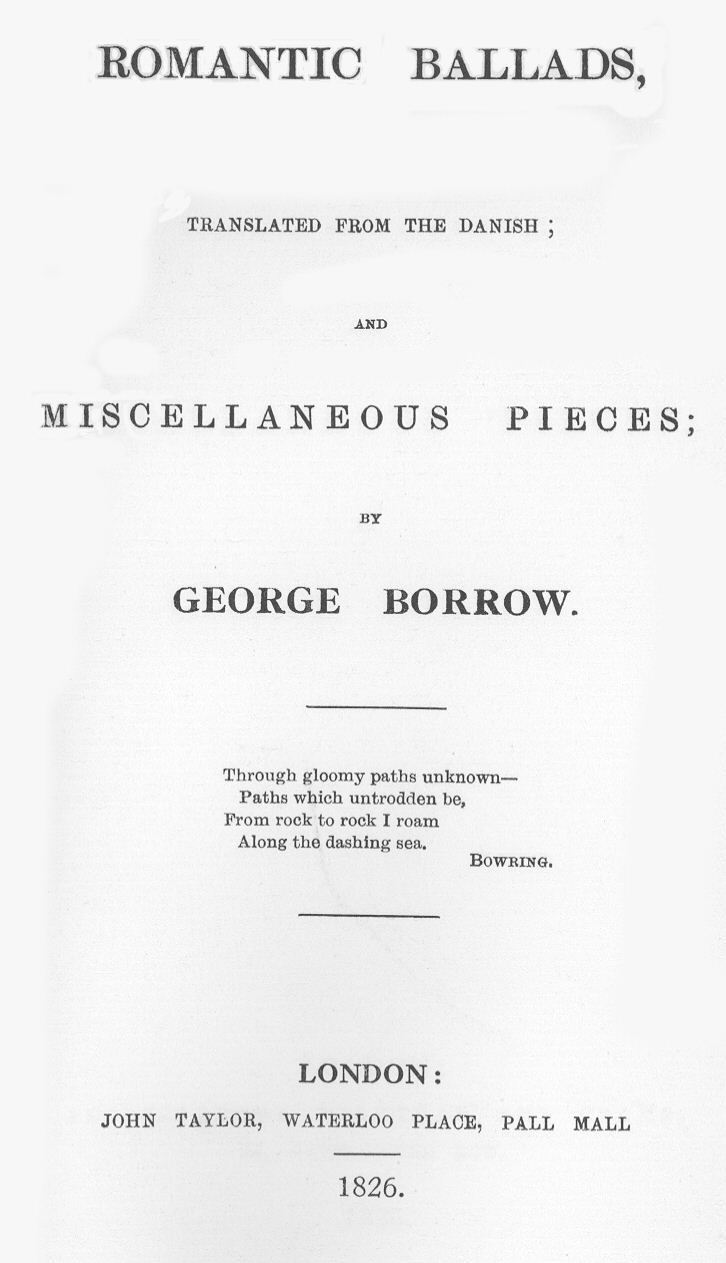Transcribed from the 1913 Jarrold and Sons edition by David Price,
ROMANTIC BALLADS,
TRANSLATED FROM THE DANISH;
AND
MISCELLANEOUS PIECES;
by
GEORGE BORROW.
* * * * *
Through gloomy paths unknown—
Paths which untrodden be,
From rock to rock I roam
Along the dashing sea.BOWRING.
* * * * *
NORWICH:
printed and published by jarrold and sons.
1913
Contents.
Preface
Lines from Allan Cunningham to George Borrow
The Death-raven. From the Danish of Oehlenslæger
Fridleif and Helga. From the Danish of Oehlenslæger
Sir Middel. From the Old Danish
Elvir-shades. From the Danish of Oehlenslæger
The Heddybee-spectre. From the Old Danish
Sir John. From the Old Danish
May Asda. From the Danish of Oehlenslæger
Aager and Eliza. From the Old Danish
Saint Oluf. From the Old Danish
The Heroes of Dovrefeld. From the Old Danish
Svend Vonved. From the Old Danish
The Tournament. From the Old Danish
Vidrik Verlandson. From the Old Danish
Elvir Hill. From the Old Danish
Waldemar’s Chase
The Merman. From the Old Danish
The Deceived Merman. From the Old Danish
Miscellanies.
Cantata
The Hail-storm. From the Norse
The Elder-witch
Ode. From the Gælic
Bear song. From the Danish of Evald
National song. From the Danish of Evald
The Old Oak
Lines to Six-foot Three
Nature’s Temperaments. From the Danish of Oehlenslæger
The Violet-gatherer. From the Danish of Oehlenslæger
Ode to a Mountain-torrent. From the German of Stolberg
Runic Verses
Thoughts on Death. From the Swedish of C. Lohman
Birds of Passage. From the Swedish
The Broken Harp
Scenes
The Suicide’s Grave. From the German
The Original Title Page.
200 copies by subscription
The London (John Taylor) Title Page.
300 copies including those bearing the imprint of
Wightman & Cramp.
PREFACE
The ballads in this volume are translated from the Works of Oehlenslæger, (a poet who is yetliving, and who stands high in the estimation of his countrymen,)and from the Kiæmpé Viser, a collection of old songs, celebrating the actions of the ancient heroes of Scandinavia.
The old Danish poets were, for the most part, extremely rude in their versification. Their stanzas of four or two lines have not the full rhyme of vowel and consonant, but merely what the Spaniards call the “assonante,” or vowel rhyme, and attention seldom seems to have been paid to the number of feet on which the lines moved along. But, however defective their poetry may be in point of harmony of numbers, it describes, in vivid and barbaric language,

